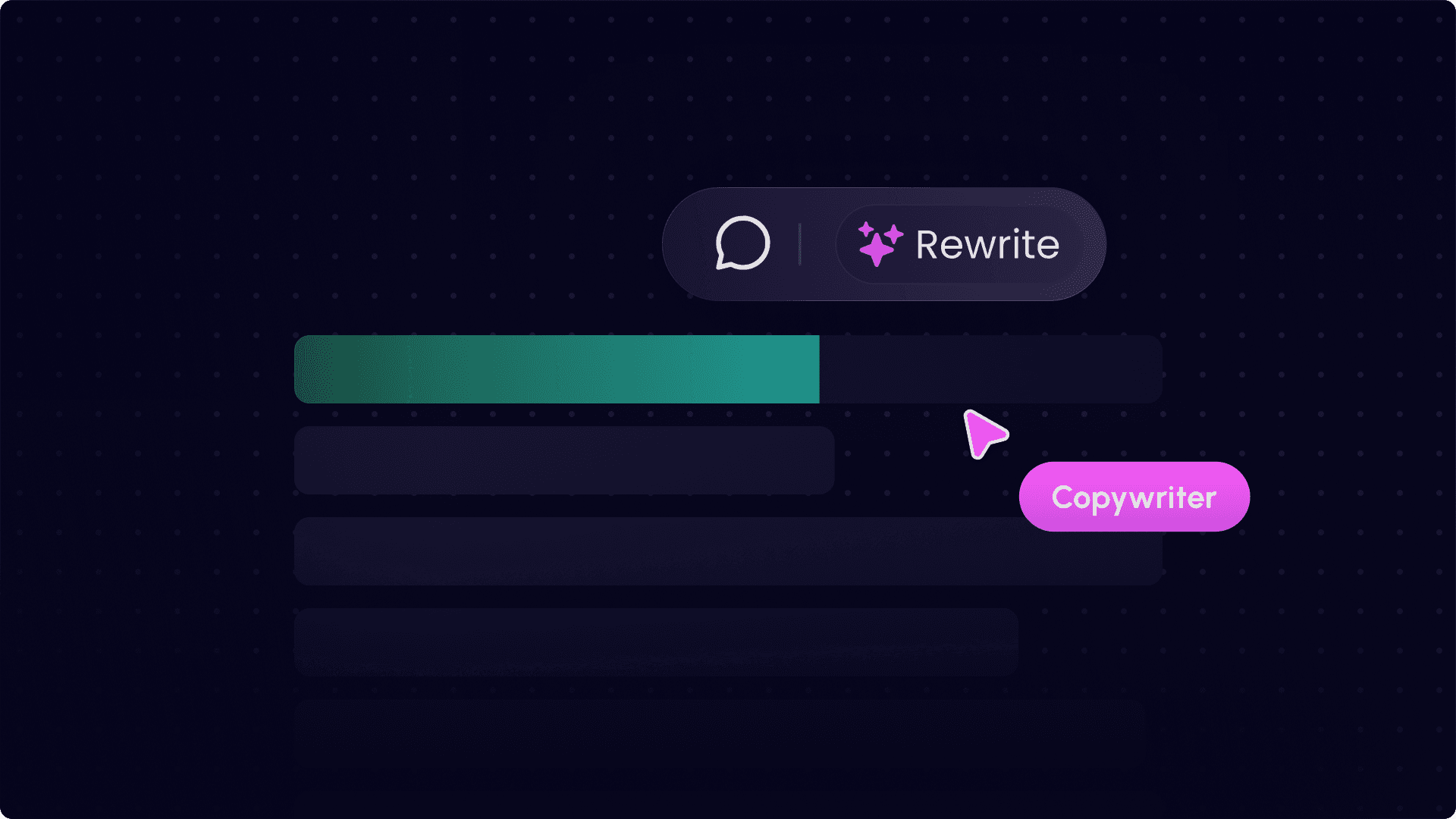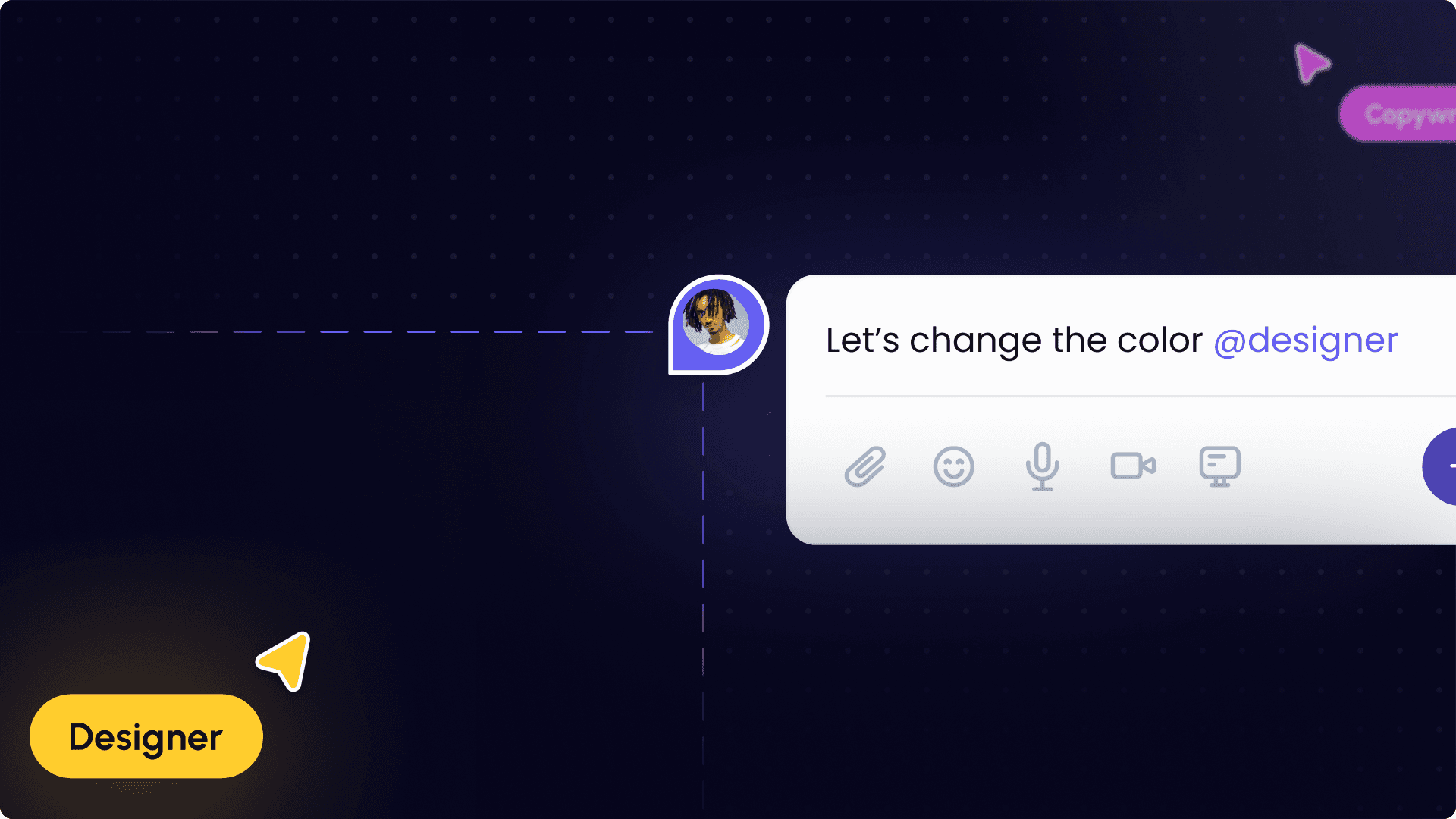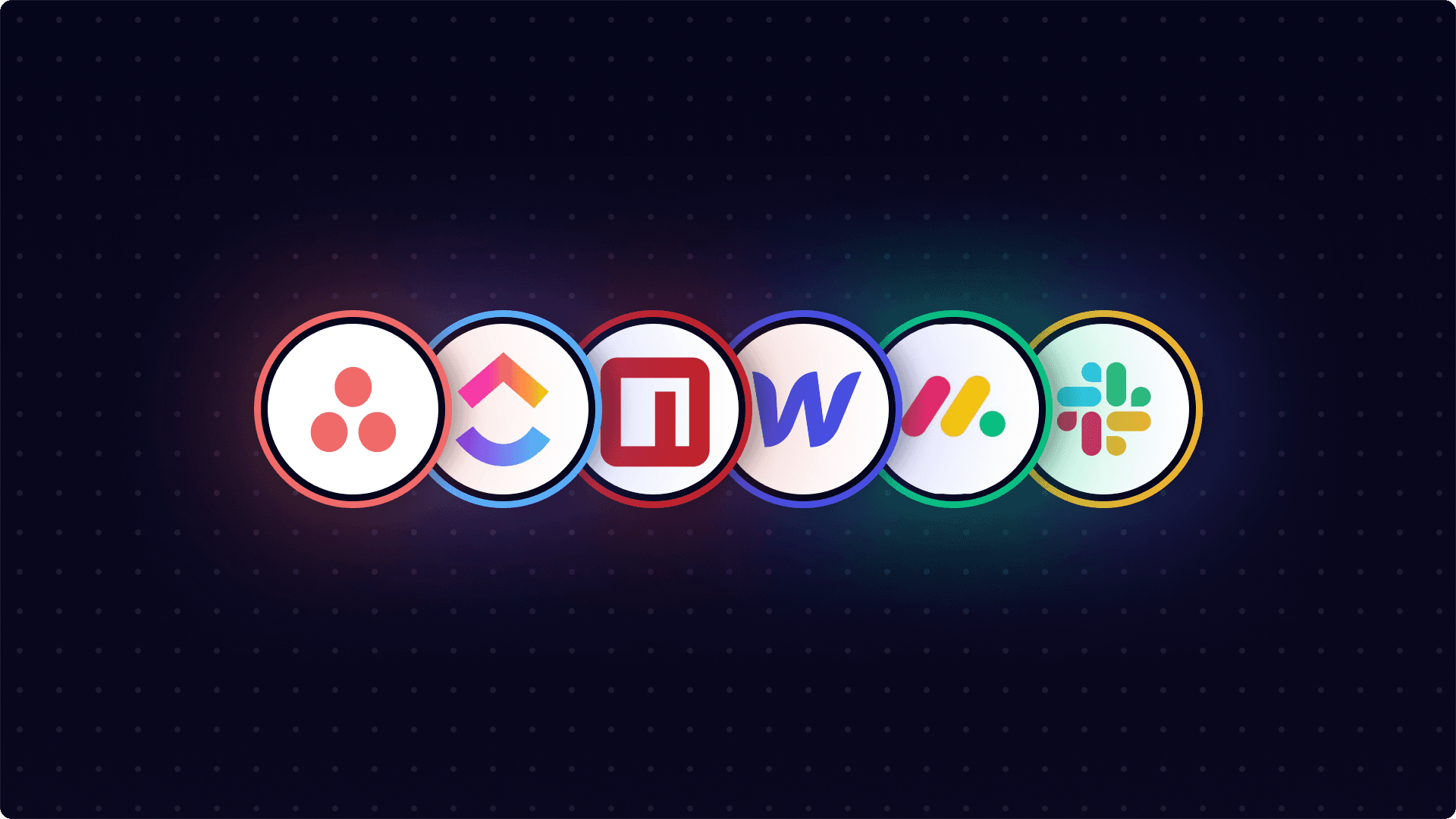Guides
Optimizing Team and Agency-Client Collaboration: Nine Key Practices for Enhanced Synergy

Emma
Nov 16, 2023
8 min read





TABLE OF CONTENT
Introduction
Have you ever had to restart a project because of poor project execution resulting from poor team communication? Or have you lost a client due poor website collaboration process?
The above instances highlight the effect of inefficient communication and collaboration, both within teams and with clients. Whether your team conducts regular meetings or not, sharing information and resources is always necessary, resulting in the need for collaboration apps. As a result, I've put this together to show you how you can effectively collaborate with your team and clients.
I'll share:
What makes up the collaboration ecosystem for modern agencies
What is Superflow, and why is it an effective collaboration tool?
9 Best Practices for Teams and Agency-client Collaboration
Let's get started!
Table of content
The collaboration ecosystem includes various applications and software that improve teamwork and communication between team members and clients, ultimately enhancing project management for websites and organizations.
Some of these applications include:
The collaboration ecosystem includes various applications and software that improve teamwork and communication between team members and clients, ultimately enhancing project management for websites and organizations.
Some of these applications include:
The collaboration ecosystem includes various applications and software that improve teamwork and communication between team members and clients, ultimately enhancing project management for websites and organizations.
Some of these applications include:
The collaboration ecosystem includes various applications and software that improve teamwork and communication between team members and clients, ultimately enhancing project management for websites and organizations.
Some of these applications include:
The collaboration ecosystem includes various applications and software that improve teamwork and communication between team members and clients, ultimately enhancing project management for websites and organizations.
Some of these applications include:
Asana is a solution that enables you to track tasks and deadlines, share files, create detailed to-do lists, and organize assignments. And all these are essential in running your business.
This task management software has features like workspaces, projects, tasks, sections, and more, that can enhance a business' efficient management of projects among teams and for clients. As a result, you can use it to pursue goals and accomplish tasks faster with fewer resources.
Below are some limitations of Asana:
Asana's interface is complex. Because of that, you may need to change your work processes to align with the tool's requirements. Additionally, there is a need for more layouts and theme colors to enhance user experience.
Asana lacks budgeting and time planning features, requiring users to seek separate solutions for these needs. And managing items across multiple projects with simultaneous due dates can be challenging.
The application is text-based and vulnerable to unauthorized edits, which can lead to structural issues, job removals, or changes in task names.
Asana cannot assign multiple individuals to the same task.
Asana is a solution that enables you to track tasks and deadlines, share files, create detailed to-do lists, and organize assignments. And all these are essential in running your business.
This task management software has features like workspaces, projects, tasks, sections, and more, that can enhance a business' efficient management of projects among teams and for clients. As a result, you can use it to pursue goals and accomplish tasks faster with fewer resources.
Below are some limitations of Asana:
Asana's interface is complex. Because of that, you may need to change your work processes to align with the tool's requirements. Additionally, there is a need for more layouts and theme colors to enhance user experience.
Asana lacks budgeting and time planning features, requiring users to seek separate solutions for these needs. And managing items across multiple projects with simultaneous due dates can be challenging.
The application is text-based and vulnerable to unauthorized edits, which can lead to structural issues, job removals, or changes in task names.
Asana cannot assign multiple individuals to the same task.
Asana is a solution that enables you to track tasks and deadlines, share files, create detailed to-do lists, and organize assignments. And all these are essential in running your business.
This task management software has features like workspaces, projects, tasks, sections, and more, that can enhance a business' efficient management of projects among teams and for clients. As a result, you can use it to pursue goals and accomplish tasks faster with fewer resources.
Below are some limitations of Asana:
Asana's interface is complex. Because of that, you may need to change your work processes to align with the tool's requirements. Additionally, there is a need for more layouts and theme colors to enhance user experience.
Asana lacks budgeting and time planning features, requiring users to seek separate solutions for these needs. And managing items across multiple projects with simultaneous due dates can be challenging.
The application is text-based and vulnerable to unauthorized edits, which can lead to structural issues, job removals, or changes in task names.
Asana cannot assign multiple individuals to the same task.
Asana is a solution that enables you to track tasks and deadlines, share files, create detailed to-do lists, and organize assignments. And all these are essential in running your business.
This task management software has features like workspaces, projects, tasks, sections, and more, that can enhance a business' efficient management of projects among teams and for clients. As a result, you can use it to pursue goals and accomplish tasks faster with fewer resources.
Below are some limitations of Asana:
Asana's interface is complex. Because of that, you may need to change your work processes to align with the tool's requirements. Additionally, there is a need for more layouts and theme colors to enhance user experience.
Asana lacks budgeting and time planning features, requiring users to seek separate solutions for these needs. And managing items across multiple projects with simultaneous due dates can be challenging.
The application is text-based and vulnerable to unauthorized edits, which can lead to structural issues, job removals, or changes in task names.
Asana cannot assign multiple individuals to the same task.
Asana is a solution that enables you to track tasks and deadlines, share files, create detailed to-do lists, and organize assignments. And all these are essential in running your business.
This task management software has features like workspaces, projects, tasks, sections, and more, that can enhance a business' efficient management of projects among teams and for clients. As a result, you can use it to pursue goals and accomplish tasks faster with fewer resources.
Below are some limitations of Asana:
Asana's interface is complex. Because of that, you may need to change your work processes to align with the tool's requirements. Additionally, there is a need for more layouts and theme colors to enhance user experience.
Asana lacks budgeting and time planning features, requiring users to seek separate solutions for these needs. And managing items across multiple projects with simultaneous due dates can be challenging.
The application is text-based and vulnerable to unauthorized edits, which can lead to structural issues, job removals, or changes in task names.
Asana cannot assign multiple individuals to the same task.
Notion offers a versatile interface supporting the creation of boards, lists, calendars, stock galleries, and timelines, providing a comprehensive solution for seamless workflow management. In addition, it offers features like document sharing, commenting, and note-taking to enhance collaboration for successful and team-friendly projects. Nevertheless, Notion isn't void of limitations.
Here are some limitations of Notion:
The app's absence of video and audio conferencing features restricts real-time communication effectiveness. As a result, collaboration among team members is solely via text (commenting and mentioning).
The app's complex interface poses challenges for some team members, particularly newbies, making navigating and adapting to the platform difficult.
The application lacks options for visualizing data. For example, it doesn't have a real offline mode.
Formatting text in the app has limitations; users cannot edit font sizes in the body of the text and cannot customize heading and subheading styles.
Notion offers a versatile interface supporting the creation of boards, lists, calendars, stock galleries, and timelines, providing a comprehensive solution for seamless workflow management. In addition, it offers features like document sharing, commenting, and note-taking to enhance collaboration for successful and team-friendly projects. Nevertheless, Notion isn't void of limitations.
Here are some limitations of Notion:
The app's absence of video and audio conferencing features restricts real-time communication effectiveness. As a result, collaboration among team members is solely via text (commenting and mentioning).
The app's complex interface poses challenges for some team members, particularly newbies, making navigating and adapting to the platform difficult.
The application lacks options for visualizing data. For example, it doesn't have a real offline mode.
Formatting text in the app has limitations; users cannot edit font sizes in the body of the text and cannot customize heading and subheading styles.
Notion offers a versatile interface supporting the creation of boards, lists, calendars, stock galleries, and timelines, providing a comprehensive solution for seamless workflow management. In addition, it offers features like document sharing, commenting, and note-taking to enhance collaboration for successful and team-friendly projects. Nevertheless, Notion isn't void of limitations.
Here are some limitations of Notion:
The app's absence of video and audio conferencing features restricts real-time communication effectiveness. As a result, collaboration among team members is solely via text (commenting and mentioning).
The app's complex interface poses challenges for some team members, particularly newbies, making navigating and adapting to the platform difficult.
The application lacks options for visualizing data. For example, it doesn't have a real offline mode.
Formatting text in the app has limitations; users cannot edit font sizes in the body of the text and cannot customize heading and subheading styles.
Notion offers a versatile interface supporting the creation of boards, lists, calendars, stock galleries, and timelines, providing a comprehensive solution for seamless workflow management. In addition, it offers features like document sharing, commenting, and note-taking to enhance collaboration for successful and team-friendly projects. Nevertheless, Notion isn't void of limitations.
Here are some limitations of Notion:
The app's absence of video and audio conferencing features restricts real-time communication effectiveness. As a result, collaboration among team members is solely via text (commenting and mentioning).
The app's complex interface poses challenges for some team members, particularly newbies, making navigating and adapting to the platform difficult.
The application lacks options for visualizing data. For example, it doesn't have a real offline mode.
Formatting text in the app has limitations; users cannot edit font sizes in the body of the text and cannot customize heading and subheading styles.
Notion offers a versatile interface supporting the creation of boards, lists, calendars, stock galleries, and timelines, providing a comprehensive solution for seamless workflow management. In addition, it offers features like document sharing, commenting, and note-taking to enhance collaboration for successful and team-friendly projects. Nevertheless, Notion isn't void of limitations.
Here are some limitations of Notion:
The app's absence of video and audio conferencing features restricts real-time communication effectiveness. As a result, collaboration among team members is solely via text (commenting and mentioning).
The app's complex interface poses challenges for some team members, particularly newbies, making navigating and adapting to the platform difficult.
The application lacks options for visualizing data. For example, it doesn't have a real offline mode.
Formatting text in the app has limitations; users cannot edit font sizes in the body of the text and cannot customize heading and subheading styles.
Trello collaboration tool uses the basic Kanban board concept, offering more than just a platform for task organization. Some Key elements of Trello include boards, lists, and cards.
As a user, you can organize tasks on boards using labels such as to-do, in progress, done, and others—a familiar system for many. In Trello, these labels correspond to lists of tasks named. For example, you can have a task titled "to-do" to form a single list. This dynamic system enhances task management and adaptability within the Trello platform.
Below are some limitations of Trello:
Trello lacks built-in features like Gantt-chart views or timeline management, which are crucial for visualizing project schedules, identifying critical paths, and managing resource allocation effectively. Additionally, Trello falls short in providing comprehensive resource management functionalities, including workload allocation, capacity planning, and resource leveling.
The application lacks a time tracker, making you lose track of time while handling projects.
Notion lacks advanced features like audio and video, limiting the real-time feel of team communication. Additionally, its offline functionality is quite limited.
Trello collaboration tool uses the basic Kanban board concept, offering more than just a platform for task organization. Some Key elements of Trello include boards, lists, and cards.
As a user, you can organize tasks on boards using labels such as to-do, in progress, done, and others—a familiar system for many. In Trello, these labels correspond to lists of tasks named. For example, you can have a task titled "to-do" to form a single list. This dynamic system enhances task management and adaptability within the Trello platform.
Below are some limitations of Trello:
Trello lacks built-in features like Gantt-chart views or timeline management, which are crucial for visualizing project schedules, identifying critical paths, and managing resource allocation effectively. Additionally, Trello falls short in providing comprehensive resource management functionalities, including workload allocation, capacity planning, and resource leveling.
The application lacks a time tracker, making you lose track of time while handling projects.
Notion lacks advanced features like audio and video, limiting the real-time feel of team communication. Additionally, its offline functionality is quite limited.
Trello collaboration tool uses the basic Kanban board concept, offering more than just a platform for task organization. Some Key elements of Trello include boards, lists, and cards.
As a user, you can organize tasks on boards using labels such as to-do, in progress, done, and others—a familiar system for many. In Trello, these labels correspond to lists of tasks named. For example, you can have a task titled "to-do" to form a single list. This dynamic system enhances task management and adaptability within the Trello platform.
Below are some limitations of Trello:
Trello lacks built-in features like Gantt-chart views or timeline management, which are crucial for visualizing project schedules, identifying critical paths, and managing resource allocation effectively. Additionally, Trello falls short in providing comprehensive resource management functionalities, including workload allocation, capacity planning, and resource leveling.
The application lacks a time tracker, making you lose track of time while handling projects.
Notion lacks advanced features like audio and video, limiting the real-time feel of team communication. Additionally, its offline functionality is quite limited.
Trello collaboration tool uses the basic Kanban board concept, offering more than just a platform for task organization. Some Key elements of Trello include boards, lists, and cards.
As a user, you can organize tasks on boards using labels such as to-do, in progress, done, and others—a familiar system for many. In Trello, these labels correspond to lists of tasks named. For example, you can have a task titled "to-do" to form a single list. This dynamic system enhances task management and adaptability within the Trello platform.
Below are some limitations of Trello:
Trello lacks built-in features like Gantt-chart views or timeline management, which are crucial for visualizing project schedules, identifying critical paths, and managing resource allocation effectively. Additionally, Trello falls short in providing comprehensive resource management functionalities, including workload allocation, capacity planning, and resource leveling.
The application lacks a time tracker, making you lose track of time while handling projects.
Notion lacks advanced features like audio and video, limiting the real-time feel of team communication. Additionally, its offline functionality is quite limited.
Trello collaboration tool uses the basic Kanban board concept, offering more than just a platform for task organization. Some Key elements of Trello include boards, lists, and cards.
As a user, you can organize tasks on boards using labels such as to-do, in progress, done, and others—a familiar system for many. In Trello, these labels correspond to lists of tasks named. For example, you can have a task titled "to-do" to form a single list. This dynamic system enhances task management and adaptability within the Trello platform.
Below are some limitations of Trello:
Trello lacks built-in features like Gantt-chart views or timeline management, which are crucial for visualizing project schedules, identifying critical paths, and managing resource allocation effectively. Additionally, Trello falls short in providing comprehensive resource management functionalities, including workload allocation, capacity planning, and resource leveling.
The application lacks a time tracker, making you lose track of time while handling projects.
Notion lacks advanced features like audio and video, limiting the real-time feel of team communication. Additionally, its offline functionality is quite limited.
Google Docs, a component of Google Workspace, serves as a collaborative tool for real-time typing and editing of documents. This tool allows multiple users to share, open, and edit documents concurrently. Also, it displays the texts of collaborators character-by-character as they make edits. Additionally, Google Docs automatically saves all modifications to Google's servers, allowing users to save revision history and past edits.
Here are some limitations of Google Docs:
Google Docs lacks a desktop version with more offline focus as it's optimized particularly for online usage.
Formatting issues and incompatibilities may arise when you import documents from other software like Word or Open Docs. These issues can pose a challenge when external contractors or clients use one of these word processors.
The software lacks font support, and there are no options to add third-party fonts.
Security issues may arise if your document link gets into the custody of an unauthorized user, potentially leading to a disaster.
As a business owner or agency, profitability stems from efficiency—accomplishing tasks and achieving results with limited resources. The highlighted collaboration tools are helpful to businesses even with their defects. Now, imagine a tool that optimizes their features and mitigates their limitations; here's where Superflow steals the show.
Google Docs, a component of Google Workspace, serves as a collaborative tool for real-time typing and editing of documents. This tool allows multiple users to share, open, and edit documents concurrently. Also, it displays the texts of collaborators character-by-character as they make edits. Additionally, Google Docs automatically saves all modifications to Google's servers, allowing users to save revision history and past edits.
Here are some limitations of Google Docs:
Google Docs lacks a desktop version with more offline focus as it's optimized particularly for online usage.
Formatting issues and incompatibilities may arise when you import documents from other software like Word or Open Docs. These issues can pose a challenge when external contractors or clients use one of these word processors.
The software lacks font support, and there are no options to add third-party fonts.
Security issues may arise if your document link gets into the custody of an unauthorized user, potentially leading to a disaster.
As a business owner or agency, profitability stems from efficiency—accomplishing tasks and achieving results with limited resources. The highlighted collaboration tools are helpful to businesses even with their defects. Now, imagine a tool that optimizes their features and mitigates their limitations; here's where Superflow steals the show.
Google Docs, a component of Google Workspace, serves as a collaborative tool for real-time typing and editing of documents. This tool allows multiple users to share, open, and edit documents concurrently. Also, it displays the texts of collaborators character-by-character as they make edits. Additionally, Google Docs automatically saves all modifications to Google's servers, allowing users to save revision history and past edits.
Here are some limitations of Google Docs:
Google Docs lacks a desktop version with more offline focus as it's optimized particularly for online usage.
Formatting issues and incompatibilities may arise when you import documents from other software like Word or Open Docs. These issues can pose a challenge when external contractors or clients use one of these word processors.
The software lacks font support, and there are no options to add third-party fonts.
Security issues may arise if your document link gets into the custody of an unauthorized user, potentially leading to a disaster.
As a business owner or agency, profitability stems from efficiency—accomplishing tasks and achieving results with limited resources. The highlighted collaboration tools are helpful to businesses even with their defects. Now, imagine a tool that optimizes their features and mitigates their limitations; here's where Superflow steals the show.
Google Docs, a component of Google Workspace, serves as a collaborative tool for real-time typing and editing of documents. This tool allows multiple users to share, open, and edit documents concurrently. Also, it displays the texts of collaborators character-by-character as they make edits. Additionally, Google Docs automatically saves all modifications to Google's servers, allowing users to save revision history and past edits.
Here are some limitations of Google Docs:
Google Docs lacks a desktop version with more offline focus as it's optimized particularly for online usage.
Formatting issues and incompatibilities may arise when you import documents from other software like Word or Open Docs. These issues can pose a challenge when external contractors or clients use one of these word processors.
The software lacks font support, and there are no options to add third-party fonts.
Security issues may arise if your document link gets into the custody of an unauthorized user, potentially leading to a disaster.
As a business owner or agency, profitability stems from efficiency—accomplishing tasks and achieving results with limited resources. The highlighted collaboration tools are helpful to businesses even with their defects. Now, imagine a tool that optimizes their features and mitigates their limitations; here's where Superflow steals the show.
Google Docs, a component of Google Workspace, serves as a collaborative tool for real-time typing and editing of documents. This tool allows multiple users to share, open, and edit documents concurrently. Also, it displays the texts of collaborators character-by-character as they make edits. Additionally, Google Docs automatically saves all modifications to Google's servers, allowing users to save revision history and past edits.
Here are some limitations of Google Docs:
Google Docs lacks a desktop version with more offline focus as it's optimized particularly for online usage.
Formatting issues and incompatibilities may arise when you import documents from other software like Word or Open Docs. These issues can pose a challenge when external contractors or clients use one of these word processors.
The software lacks font support, and there are no options to add third-party fonts.
Security issues may arise if your document link gets into the custody of an unauthorized user, potentially leading to a disaster.
As a business owner or agency, profitability stems from efficiency—accomplishing tasks and achieving results with limited resources. The highlighted collaboration tools are helpful to businesses even with their defects. Now, imagine a tool that optimizes their features and mitigates their limitations; here's where Superflow steals the show.
Superflow is a collaborative platform tailored for teams looking to elevate their design process and garner precise feedback on projects. It is a robust tool, revolutionizing the landscape of website collaboration and iteration.
Superflow empowers teams to comment and collaborate directly on the website, facilitating seamless communication and efficient workflows. This eliminates the need for numerous back-and-forth emails and time-consuming meetings, streamlining the collaborative design process.
Superflow stands out as a superior alternative to other tools due to its outstanding features, embodying best practices that enhance team and agency-client collaboration in website development and project management for websites and businesses.
Sign Up to get started with Superflow.
Superflow is a collaborative platform tailored for teams looking to elevate their design process and garner precise feedback on projects. It is a robust tool, revolutionizing the landscape of website collaboration and iteration.
Superflow empowers teams to comment and collaborate directly on the website, facilitating seamless communication and efficient workflows. This eliminates the need for numerous back-and-forth emails and time-consuming meetings, streamlining the collaborative design process.
Superflow stands out as a superior alternative to other tools due to its outstanding features, embodying best practices that enhance team and agency-client collaboration in website development and project management for websites and businesses.
Sign Up to get started with Superflow.
Superflow is a collaborative platform tailored for teams looking to elevate their design process and garner precise feedback on projects. It is a robust tool, revolutionizing the landscape of website collaboration and iteration.
Superflow empowers teams to comment and collaborate directly on the website, facilitating seamless communication and efficient workflows. This eliminates the need for numerous back-and-forth emails and time-consuming meetings, streamlining the collaborative design process.
Superflow stands out as a superior alternative to other tools due to its outstanding features, embodying best practices that enhance team and agency-client collaboration in website development and project management for websites and businesses.
Sign Up to get started with Superflow.
Superflow is a collaborative platform tailored for teams looking to elevate their design process and garner precise feedback on projects. It is a robust tool, revolutionizing the landscape of website collaboration and iteration.
Superflow empowers teams to comment and collaborate directly on the website, facilitating seamless communication and efficient workflows. This eliminates the need for numerous back-and-forth emails and time-consuming meetings, streamlining the collaborative design process.
Superflow stands out as a superior alternative to other tools due to its outstanding features, embodying best practices that enhance team and agency-client collaboration in website development and project management for websites and businesses.
Sign Up to get started with Superflow.
Superflow is a collaborative platform tailored for teams looking to elevate their design process and garner precise feedback on projects. It is a robust tool, revolutionizing the landscape of website collaboration and iteration.
Superflow empowers teams to comment and collaborate directly on the website, facilitating seamless communication and efficient workflows. This eliminates the need for numerous back-and-forth emails and time-consuming meetings, streamlining the collaborative design process.
Superflow stands out as a superior alternative to other tools due to its outstanding features, embodying best practices that enhance team and agency-client collaboration in website development and project management for websites and businesses.
Sign Up to get started with Superflow.
Effective collaboration between teams and agency-client relationships is crucial for achieving successful outcomes in any project or business endeavor. The synergy between these two can significantly impact productivity, creativity, and overall project success.
Below, we will share nine 9 best practices for collaboration and how Superflow helps to achieve them.
Effective collaboration between teams and agency-client relationships is crucial for achieving successful outcomes in any project or business endeavor. The synergy between these two can significantly impact productivity, creativity, and overall project success.
Below, we will share nine 9 best practices for collaboration and how Superflow helps to achieve them.
Effective collaboration between teams and agency-client relationships is crucial for achieving successful outcomes in any project or business endeavor. The synergy between these two can significantly impact productivity, creativity, and overall project success.
Below, we will share nine 9 best practices for collaboration and how Superflow helps to achieve them.
Effective collaboration between teams and agency-client relationships is crucial for achieving successful outcomes in any project or business endeavor. The synergy between these two can significantly impact productivity, creativity, and overall project success.
Below, we will share nine 9 best practices for collaboration and how Superflow helps to achieve them.
Effective collaboration between teams and agency-client relationships is crucial for achieving successful outcomes in any project or business endeavor. The synergy between these two can significantly impact productivity, creativity, and overall project success.
Below, we will share nine 9 best practices for collaboration and how Superflow helps to achieve them.
Effective communication is vital for a successful collaboration. As a result, you need to use real-time communication tools like instant messaging platforms with video capabilities to ensure that your team members and clients stay connected.
Superflow achieves this by offering an asynchronous communication feature, allowing users to comment clearly and concisely. Additionally, Superflow goes beyond text communication, providing real-time collaboration with audio, video, screen sharing, and recording capabilities. Further, its AI transcriptions ensure seamless communication within the team, plus it delivers a Flock mode that enables users to guide others through the website, facilitating a robust interaction experience.
Effective communication is vital for a successful collaboration. As a result, you need to use real-time communication tools like instant messaging platforms with video capabilities to ensure that your team members and clients stay connected.
Superflow achieves this by offering an asynchronous communication feature, allowing users to comment clearly and concisely. Additionally, Superflow goes beyond text communication, providing real-time collaboration with audio, video, screen sharing, and recording capabilities. Further, its AI transcriptions ensure seamless communication within the team, plus it delivers a Flock mode that enables users to guide others through the website, facilitating a robust interaction experience.
Effective communication is vital for a successful collaboration. As a result, you need to use real-time communication tools like instant messaging platforms with video capabilities to ensure that your team members and clients stay connected.
Superflow achieves this by offering an asynchronous communication feature, allowing users to comment clearly and concisely. Additionally, Superflow goes beyond text communication, providing real-time collaboration with audio, video, screen sharing, and recording capabilities. Further, its AI transcriptions ensure seamless communication within the team, plus it delivers a Flock mode that enables users to guide others through the website, facilitating a robust interaction experience.
Effective communication is vital for a successful collaboration. As a result, you need to use real-time communication tools like instant messaging platforms with video capabilities to ensure that your team members and clients stay connected.
Superflow achieves this by offering an asynchronous communication feature, allowing users to comment clearly and concisely. Additionally, Superflow goes beyond text communication, providing real-time collaboration with audio, video, screen sharing, and recording capabilities. Further, its AI transcriptions ensure seamless communication within the team, plus it delivers a Flock mode that enables users to guide others through the website, facilitating a robust interaction experience.
Effective communication is vital for a successful collaboration. As a result, you need to use real-time communication tools like instant messaging platforms with video capabilities to ensure that your team members and clients stay connected.
Superflow achieves this by offering an asynchronous communication feature, allowing users to comment clearly and concisely. Additionally, Superflow goes beyond text communication, providing real-time collaboration with audio, video, screen sharing, and recording capabilities. Further, its AI transcriptions ensure seamless communication within the team, plus it delivers a Flock mode that enables users to guide others through the website, facilitating a robust interaction experience.
Collaborative document editing tools ensure team members and clients work on shared documents in real time. This promotes transparency, reduces version control issues, and ensures everyone is on the same page.

In line with this, Superflow permits multiple authorized users to edit and save documents seamlessly, ensuring that formatting is not a hurdle. Additionally, it integrates ChatGPT within your website, enabling prompt communication and contextual rewriting of comments. Learn more about Superflow’s chatgbt feature.
Collaborative document editing tools ensure team members and clients work on shared documents in real time. This promotes transparency, reduces version control issues, and ensures everyone is on the same page.

In line with this, Superflow permits multiple authorized users to edit and save documents seamlessly, ensuring that formatting is not a hurdle. Additionally, it integrates ChatGPT within your website, enabling prompt communication and contextual rewriting of comments. Learn more about Superflow’s chatgbt feature.
Collaborative document editing tools ensure team members and clients work on shared documents in real time. This promotes transparency, reduces version control issues, and ensures everyone is on the same page.

In line with this, Superflow permits multiple authorized users to edit and save documents seamlessly, ensuring that formatting is not a hurdle. Additionally, it integrates ChatGPT within your website, enabling prompt communication and contextual rewriting of comments. Learn more about Superflow’s chatgbt feature.
Collaborative document editing tools ensure team members and clients work on shared documents in real time. This promotes transparency, reduces version control issues, and ensures everyone is on the same page.

In line with this, Superflow permits multiple authorized users to edit and save documents seamlessly, ensuring that formatting is not a hurdle. Additionally, it integrates ChatGPT within your website, enabling prompt communication and contextual rewriting of comments. Learn more about Superflow’s chatgbt feature.
Collaborative document editing tools ensure team members and clients work on shared documents in real time. This promotes transparency, reduces version control issues, and ensures everyone is on the same page.

In line with this, Superflow permits multiple authorized users to edit and save documents seamlessly, ensuring that formatting is not a hurdle. Additionally, it integrates ChatGPT within your website, enabling prompt communication and contextual rewriting of comments. Learn more about Superflow’s chatgbt feature.
Centralized project dashboards offer a clear visual representation of project progress, timelines, and milestones. Integrating these dashboards with project management tools gives you a detailed view of activities to track progress efficiently.
If you like to perform tasks with tools like Google Docs or Trello, Superflow accommodates your preferences. It supports seamless integration options with popular platforms like Google Sheets, Slack, and Trello. This promotes a cohesive and efficient workflow, plus improved task management. Furthermore, Superflow offers support for webhooks, allowing you to set up custom rules, notifications, and data processing.
Centralized project dashboards offer a clear visual representation of project progress, timelines, and milestones. Integrating these dashboards with project management tools gives you a detailed view of activities to track progress efficiently.
If you like to perform tasks with tools like Google Docs or Trello, Superflow accommodates your preferences. It supports seamless integration options with popular platforms like Google Sheets, Slack, and Trello. This promotes a cohesive and efficient workflow, plus improved task management. Furthermore, Superflow offers support for webhooks, allowing you to set up custom rules, notifications, and data processing.
Centralized project dashboards offer a clear visual representation of project progress, timelines, and milestones. Integrating these dashboards with project management tools gives you a detailed view of activities to track progress efficiently.
If you like to perform tasks with tools like Google Docs or Trello, Superflow accommodates your preferences. It supports seamless integration options with popular platforms like Google Sheets, Slack, and Trello. This promotes a cohesive and efficient workflow, plus improved task management. Furthermore, Superflow offers support for webhooks, allowing you to set up custom rules, notifications, and data processing.
Centralized project dashboards offer a clear visual representation of project progress, timelines, and milestones. Integrating these dashboards with project management tools gives you a detailed view of activities to track progress efficiently.
If you like to perform tasks with tools like Google Docs or Trello, Superflow accommodates your preferences. It supports seamless integration options with popular platforms like Google Sheets, Slack, and Trello. This promotes a cohesive and efficient workflow, plus improved task management. Furthermore, Superflow offers support for webhooks, allowing you to set up custom rules, notifications, and data processing.
Centralized project dashboards offer a clear visual representation of project progress, timelines, and milestones. Integrating these dashboards with project management tools gives you a detailed view of activities to track progress efficiently.
If you like to perform tasks with tools like Google Docs or Trello, Superflow accommodates your preferences. It supports seamless integration options with popular platforms like Google Sheets, Slack, and Trello. This promotes a cohesive and efficient workflow, plus improved task management. Furthermore, Superflow offers support for webhooks, allowing you to set up custom rules, notifications, and data processing.
Implementing a centralized feedback system streamlines the feedback process. This could be through a dedicated platform where clients and team members can provide input, ensuring that feedback is organized, accessible, and actionable.
Superflow prioritizes a centralized feedback system that improves collecting, tracking, and responding to customer feedback. This approach ensures swift resolution of complaints and queries, underlining our commitment to excellent customer support. This dedication distinguishes Superflow from other collaborative software choices.
Additionally, Superflow incorporates a commenting feature to encourage detailed feedback and discussions among internal and external users. In catering to a diverse user base, we are committed to providing personalized guidance, understanding that not everyone is a tech expert.
Implementing a centralized feedback system streamlines the feedback process. This could be through a dedicated platform where clients and team members can provide input, ensuring that feedback is organized, accessible, and actionable.
Superflow prioritizes a centralized feedback system that improves collecting, tracking, and responding to customer feedback. This approach ensures swift resolution of complaints and queries, underlining our commitment to excellent customer support. This dedication distinguishes Superflow from other collaborative software choices.
Additionally, Superflow incorporates a commenting feature to encourage detailed feedback and discussions among internal and external users. In catering to a diverse user base, we are committed to providing personalized guidance, understanding that not everyone is a tech expert.
Implementing a centralized feedback system streamlines the feedback process. This could be through a dedicated platform where clients and team members can provide input, ensuring that feedback is organized, accessible, and actionable.
Superflow prioritizes a centralized feedback system that improves collecting, tracking, and responding to customer feedback. This approach ensures swift resolution of complaints and queries, underlining our commitment to excellent customer support. This dedication distinguishes Superflow from other collaborative software choices.
Additionally, Superflow incorporates a commenting feature to encourage detailed feedback and discussions among internal and external users. In catering to a diverse user base, we are committed to providing personalized guidance, understanding that not everyone is a tech expert.
Implementing a centralized feedback system streamlines the feedback process. This could be through a dedicated platform where clients and team members can provide input, ensuring that feedback is organized, accessible, and actionable.
Superflow prioritizes a centralized feedback system that improves collecting, tracking, and responding to customer feedback. This approach ensures swift resolution of complaints and queries, underlining our commitment to excellent customer support. This dedication distinguishes Superflow from other collaborative software choices.
Additionally, Superflow incorporates a commenting feature to encourage detailed feedback and discussions among internal and external users. In catering to a diverse user base, we are committed to providing personalized guidance, understanding that not everyone is a tech expert.
Implementing a centralized feedback system streamlines the feedback process. This could be through a dedicated platform where clients and team members can provide input, ensuring that feedback is organized, accessible, and actionable.
Superflow prioritizes a centralized feedback system that improves collecting, tracking, and responding to customer feedback. This approach ensures swift resolution of complaints and queries, underlining our commitment to excellent customer support. This dedication distinguishes Superflow from other collaborative software choices.
Additionally, Superflow incorporates a commenting feature to encourage detailed feedback and discussions among internal and external users. In catering to a diverse user base, we are committed to providing personalized guidance, understanding that not everyone is a tech expert.
This deals with the level of accessibility your team members and clients have to your website to ensure the safety of information.
With effective control over access, documents, and files are only accessible to authorized users. Because of that, Superflow guarantees robust security, allowing internal (teammates) and external (clients) users access to specified information, while other details remain confidential until you consent.
This deals with the level of accessibility your team members and clients have to your website to ensure the safety of information.
With effective control over access, documents, and files are only accessible to authorized users. Because of that, Superflow guarantees robust security, allowing internal (teammates) and external (clients) users access to specified information, while other details remain confidential until you consent.
This deals with the level of accessibility your team members and clients have to your website to ensure the safety of information.
With effective control over access, documents, and files are only accessible to authorized users. Because of that, Superflow guarantees robust security, allowing internal (teammates) and external (clients) users access to specified information, while other details remain confidential until you consent.
This deals with the level of accessibility your team members and clients have to your website to ensure the safety of information.
With effective control over access, documents, and files are only accessible to authorized users. Because of that, Superflow guarantees robust security, allowing internal (teammates) and external (clients) users access to specified information, while other details remain confidential until you consent.
This deals with the level of accessibility your team members and clients have to your website to ensure the safety of information.
With effective control over access, documents, and files are only accessible to authorized users. Because of that, Superflow guarantees robust security, allowing internal (teammates) and external (clients) users access to specified information, while other details remain confidential until you consent.
Workflow automation refers to using solutions to perform tasks and enhance efficiency. Superflow, with its asynchronous communication and feedback capabilities, facilitates automatic and faster workflows for efficient collaboration. Also, the platform promotes seamless collaboration by ensuring quick adjustments and improvements to speed up project completion time.

Furthermore, Superflow speeds up workflows with built-in task management features like @mentions for searching and mentioning your team or external users for faster responses and a task assignment option to help you assign comments to specific individuals for more responsibility and accountability. It also offers a prioritization option where you can give priorities to each comment. Finally, it provides an AI auto-categorization and a built-in kanban board for an improved organization of comments.
Workflow automation refers to using solutions to perform tasks and enhance efficiency. Superflow, with its asynchronous communication and feedback capabilities, facilitates automatic and faster workflows for efficient collaboration. Also, the platform promotes seamless collaboration by ensuring quick adjustments and improvements to speed up project completion time.

Furthermore, Superflow speeds up workflows with built-in task management features like @mentions for searching and mentioning your team or external users for faster responses and a task assignment option to help you assign comments to specific individuals for more responsibility and accountability. It also offers a prioritization option where you can give priorities to each comment. Finally, it provides an AI auto-categorization and a built-in kanban board for an improved organization of comments.
Workflow automation refers to using solutions to perform tasks and enhance efficiency. Superflow, with its asynchronous communication and feedback capabilities, facilitates automatic and faster workflows for efficient collaboration. Also, the platform promotes seamless collaboration by ensuring quick adjustments and improvements to speed up project completion time.

Furthermore, Superflow speeds up workflows with built-in task management features like @mentions for searching and mentioning your team or external users for faster responses and a task assignment option to help you assign comments to specific individuals for more responsibility and accountability. It also offers a prioritization option where you can give priorities to each comment. Finally, it provides an AI auto-categorization and a built-in kanban board for an improved organization of comments.
Workflow automation refers to using solutions to perform tasks and enhance efficiency. Superflow, with its asynchronous communication and feedback capabilities, facilitates automatic and faster workflows for efficient collaboration. Also, the platform promotes seamless collaboration by ensuring quick adjustments and improvements to speed up project completion time.

Furthermore, Superflow speeds up workflows with built-in task management features like @mentions for searching and mentioning your team or external users for faster responses and a task assignment option to help you assign comments to specific individuals for more responsibility and accountability. It also offers a prioritization option where you can give priorities to each comment. Finally, it provides an AI auto-categorization and a built-in kanban board for an improved organization of comments.
Workflow automation refers to using solutions to perform tasks and enhance efficiency. Superflow, with its asynchronous communication and feedback capabilities, facilitates automatic and faster workflows for efficient collaboration. Also, the platform promotes seamless collaboration by ensuring quick adjustments and improvements to speed up project completion time.

Furthermore, Superflow speeds up workflows with built-in task management features like @mentions for searching and mentioning your team or external users for faster responses and a task assignment option to help you assign comments to specific individuals for more responsibility and accountability. It also offers a prioritization option where you can give priorities to each comment. Finally, it provides an AI auto-categorization and a built-in kanban board for an improved organization of comments.
File sharing is essential, and effective management is even more important. Many businesses and teams experience losses and other challenges when crucial information gets into unauthorized hands.
Superflow addresses this concern by enabling you to share files seamlessly with your team and clients, ensuring data security. Unlike other platforms, Superflow operates directly on your site without creating a duplicate in its sandbox. It stores your comments data in a dedicated storage space designed for you and encrypts this information in transit, adhering to industry standards to safeguard your valuable data.
File sharing is essential, and effective management is even more important. Many businesses and teams experience losses and other challenges when crucial information gets into unauthorized hands.
Superflow addresses this concern by enabling you to share files seamlessly with your team and clients, ensuring data security. Unlike other platforms, Superflow operates directly on your site without creating a duplicate in its sandbox. It stores your comments data in a dedicated storage space designed for you and encrypts this information in transit, adhering to industry standards to safeguard your valuable data.
File sharing is essential, and effective management is even more important. Many businesses and teams experience losses and other challenges when crucial information gets into unauthorized hands.
Superflow addresses this concern by enabling you to share files seamlessly with your team and clients, ensuring data security. Unlike other platforms, Superflow operates directly on your site without creating a duplicate in its sandbox. It stores your comments data in a dedicated storage space designed for you and encrypts this information in transit, adhering to industry standards to safeguard your valuable data.
File sharing is essential, and effective management is even more important. Many businesses and teams experience losses and other challenges when crucial information gets into unauthorized hands.
Superflow addresses this concern by enabling you to share files seamlessly with your team and clients, ensuring data security. Unlike other platforms, Superflow operates directly on your site without creating a duplicate in its sandbox. It stores your comments data in a dedicated storage space designed for you and encrypts this information in transit, adhering to industry standards to safeguard your valuable data.
File sharing is essential, and effective management is even more important. Many businesses and teams experience losses and other challenges when crucial information gets into unauthorized hands.
Superflow addresses this concern by enabling you to share files seamlessly with your team and clients, ensuring data security. Unlike other platforms, Superflow operates directly on your site without creating a duplicate in its sandbox. It stores your comments data in a dedicated storage space designed for you and encrypts this information in transit, adhering to industry standards to safeguard your valuable data.
Time tracking and reporting are crucial in recording work hours and providing insights into work progress, contributing to improved operational efficiency.
Superflow facilitates meticulous tracking of time spent on various tasks, projects, and clients, allowing comparison with predefined budgets or goals. The software offers comprehensive reporting and analysis features, including graphs, charts, tables, and filters, empowering you to assess and optimize time management and collaboration. Superflow supports time tracking, responsibility assignment, and progress monitoring, collectively enhancing project efficiency.
Time tracking and reporting are crucial in recording work hours and providing insights into work progress, contributing to improved operational efficiency.
Superflow facilitates meticulous tracking of time spent on various tasks, projects, and clients, allowing comparison with predefined budgets or goals. The software offers comprehensive reporting and analysis features, including graphs, charts, tables, and filters, empowering you to assess and optimize time management and collaboration. Superflow supports time tracking, responsibility assignment, and progress monitoring, collectively enhancing project efficiency.
Time tracking and reporting are crucial in recording work hours and providing insights into work progress, contributing to improved operational efficiency.
Superflow facilitates meticulous tracking of time spent on various tasks, projects, and clients, allowing comparison with predefined budgets or goals. The software offers comprehensive reporting and analysis features, including graphs, charts, tables, and filters, empowering you to assess and optimize time management and collaboration. Superflow supports time tracking, responsibility assignment, and progress monitoring, collectively enhancing project efficiency.
Time tracking and reporting are crucial in recording work hours and providing insights into work progress, contributing to improved operational efficiency.
Superflow facilitates meticulous tracking of time spent on various tasks, projects, and clients, allowing comparison with predefined budgets or goals. The software offers comprehensive reporting and analysis features, including graphs, charts, tables, and filters, empowering you to assess and optimize time management and collaboration. Superflow supports time tracking, responsibility assignment, and progress monitoring, collectively enhancing project efficiency.
Time tracking and reporting are crucial in recording work hours and providing insights into work progress, contributing to improved operational efficiency.
Superflow facilitates meticulous tracking of time spent on various tasks, projects, and clients, allowing comparison with predefined budgets or goals. The software offers comprehensive reporting and analysis features, including graphs, charts, tables, and filters, empowering you to assess and optimize time management and collaboration. Superflow supports time tracking, responsibility assignment, and progress monitoring, collectively enhancing project efficiency.
The user interface is crucial as it is the first point of contact. A complex interface can lead to user frustration and a swift dismissal of the application.
Superflow recognizes this and offers a user-friendly interface with a simple learning curve, prioritizing easy navigation for teams. By providing accessibility for all users, Superflow's customization options allow the creation of workflows tailored to specific user requirements. This focus on user-friendliness significantly enhances team and agency-client relationship success.
The user interface is crucial as it is the first point of contact. A complex interface can lead to user frustration and a swift dismissal of the application.
Superflow recognizes this and offers a user-friendly interface with a simple learning curve, prioritizing easy navigation for teams. By providing accessibility for all users, Superflow's customization options allow the creation of workflows tailored to specific user requirements. This focus on user-friendliness significantly enhances team and agency-client relationship success.
The user interface is crucial as it is the first point of contact. A complex interface can lead to user frustration and a swift dismissal of the application.
Superflow recognizes this and offers a user-friendly interface with a simple learning curve, prioritizing easy navigation for teams. By providing accessibility for all users, Superflow's customization options allow the creation of workflows tailored to specific user requirements. This focus on user-friendliness significantly enhances team and agency-client relationship success.
The user interface is crucial as it is the first point of contact. A complex interface can lead to user frustration and a swift dismissal of the application.
Superflow recognizes this and offers a user-friendly interface with a simple learning curve, prioritizing easy navigation for teams. By providing accessibility for all users, Superflow's customization options allow the creation of workflows tailored to specific user requirements. This focus on user-friendliness significantly enhances team and agency-client relationship success.
The user interface is crucial as it is the first point of contact. A complex interface can lead to user frustration and a swift dismissal of the application.
Superflow recognizes this and offers a user-friendly interface with a simple learning curve, prioritizing easy navigation for teams. By providing accessibility for all users, Superflow's customization options allow the creation of workflows tailored to specific user requirements. This focus on user-friendliness significantly enhances team and agency-client relationship success.
In conclusion, effective collaboration is crucial for successful project execution and client satisfaction. The limitations of widely used tools like Asana, Notion, Trello, and Google Docs highlight the need for a comprehensive solution.

However, Superflow bridges these limitations by offering real-time communication, collaborative document editing, integrated project dashboards, a centralized feedback system, client access controls, workflow automation, secured file sharing, time tracking, a user-friendly interface, and more. It also adopts the nine core collaboration practices to ensure improved synergy, efficient workflows, and enhanced project management for teams and agencies. Superflow's commitment to addressing the specific needs of internal and external users establishes it as a superior choice compared to other collaborative software.
Sign up to Superflow to improve your communication and transform collaboration.
In conclusion, effective collaboration is crucial for successful project execution and client satisfaction. The limitations of widely used tools like Asana, Notion, Trello, and Google Docs highlight the need for a comprehensive solution.

However, Superflow bridges these limitations by offering real-time communication, collaborative document editing, integrated project dashboards, a centralized feedback system, client access controls, workflow automation, secured file sharing, time tracking, a user-friendly interface, and more. It also adopts the nine core collaboration practices to ensure improved synergy, efficient workflows, and enhanced project management for teams and agencies. Superflow's commitment to addressing the specific needs of internal and external users establishes it as a superior choice compared to other collaborative software.
Sign up to Superflow to improve your communication and transform collaboration.
In conclusion, effective collaboration is crucial for successful project execution and client satisfaction. The limitations of widely used tools like Asana, Notion, Trello, and Google Docs highlight the need for a comprehensive solution.

However, Superflow bridges these limitations by offering real-time communication, collaborative document editing, integrated project dashboards, a centralized feedback system, client access controls, workflow automation, secured file sharing, time tracking, a user-friendly interface, and more. It also adopts the nine core collaboration practices to ensure improved synergy, efficient workflows, and enhanced project management for teams and agencies. Superflow's commitment to addressing the specific needs of internal and external users establishes it as a superior choice compared to other collaborative software.
Sign up to Superflow to improve your communication and transform collaboration.
In conclusion, effective collaboration is crucial for successful project execution and client satisfaction. The limitations of widely used tools like Asana, Notion, Trello, and Google Docs highlight the need for a comprehensive solution.

However, Superflow bridges these limitations by offering real-time communication, collaborative document editing, integrated project dashboards, a centralized feedback system, client access controls, workflow automation, secured file sharing, time tracking, a user-friendly interface, and more. It also adopts the nine core collaboration practices to ensure improved synergy, efficient workflows, and enhanced project management for teams and agencies. Superflow's commitment to addressing the specific needs of internal and external users establishes it as a superior choice compared to other collaborative software.
Sign up to Superflow to improve your communication and transform collaboration.
In conclusion, effective collaboration is crucial for successful project execution and client satisfaction. The limitations of widely used tools like Asana, Notion, Trello, and Google Docs highlight the need for a comprehensive solution.

However, Superflow bridges these limitations by offering real-time communication, collaborative document editing, integrated project dashboards, a centralized feedback system, client access controls, workflow automation, secured file sharing, time tracking, a user-friendly interface, and more. It also adopts the nine core collaboration practices to ensure improved synergy, efficient workflows, and enhanced project management for teams and agencies. Superflow's commitment to addressing the specific needs of internal and external users establishes it as a superior choice compared to other collaborative software.
Sign up to Superflow to improve your communication and transform collaboration.
Learned Something? Share it with a friend
Frequently Asked Questions
Frequently Asked Questions
Frequently Asked Questions
(FAQs)
(FAQs)
(FAQs)

01
How do you collaborate with an agency?

01
How do you collaborate with an agency?

01
How do you collaborate with an agency?

01
How do you collaborate with an agency?

02
What is the significance of a feedback mechanism in optimizing collaboration?

02
What is the significance of a feedback mechanism in optimizing collaboration?

02
What is the significance of a feedback mechanism in optimizing collaboration?

02
What is the significance of a feedback mechanism in optimizing collaboration?

03
How do you improve your agency collaboration process?

03
How do you improve your agency collaboration process?

03
How do you improve your agency collaboration process?

03
How do you improve your agency collaboration process?

04
What are some examples of collaboration tools?

04
What are some examples of collaboration tools?

04
What are some examples of collaboration tools?

04
What are some examples of collaboration tools?

05
How do I choose an online collaboration tool?

05
How do I choose an online collaboration tool?

05
How do I choose an online collaboration tool?

05
How do I choose an online collaboration tool?
More
More
Articles
Feature Release

Ready to comment & collaborate on your website?
Revise, iterate, and ship websites 10x faster.

Designer

Product Manager

Marketing

Developer

Designer

Developer

Ready to comment & collaborate on your website?
Revise, iterate, and ship websites 10x faster.

Designer

Product Manager

Marketing

Developer

Designer

Developer

Ready to comment & collaborate on your website?
Revise, iterate, and ship websites 10x faster.

Designer

Product Manager

Marketing

Developer

Designer

Developer

Ready to comment & collaborate on your website?
Revise, iterate, and ship websites 10x faster.

Designer

Product Manager

Marketing

Developer

Designer

Developer

Ready to comment & collaborate on your website?
Revise, iterate, and ship websites 10x faster.

Designer

Product Manager

Marketing

Developer

Designer

Developer

Superflow
The website feedback and collaboration tool for design & software teams.

Superflow
The website feedback and collaboration tool for design & software teams.

Superflow
The website feedback and collaboration tool for design & software teams.



